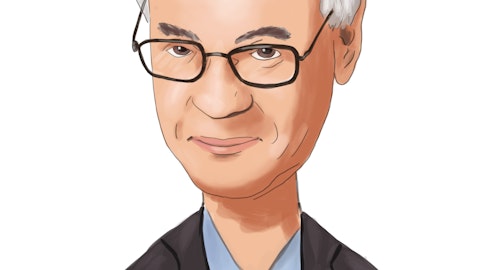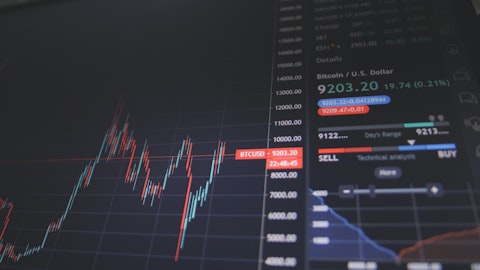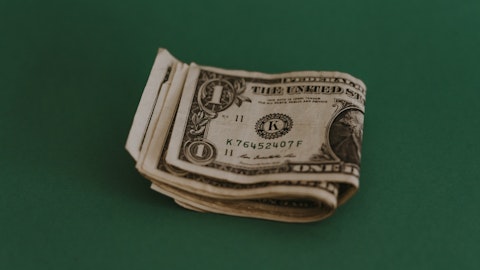Frank Schiraldi: Right. Okay, so…
Bill Burns: Okay. I wouldn’t really put a lag in on the 50%.
Frank Schiraldi: Okay. And then just in terms of growth, to the extent you get it, and you talked about some of the higher yielding product, that there’s some opportunity, even if C&I growth isn’t as great as it was in the quarter. Just wondering your thoughts on, aside from the fed and deposit rates stabilizing overall, just where net new business is coming on the books in terms of loan yields versus the funding costs as new business comes on?
Bill Burns: New business, yes, what the spreads are on our business, and the good thing about C&I is, it generally comes along with the deposits, and that’s why we focus on C&I. But I think the spreads are kind of 300 to 400 basis points on C&I lending and similar for construction.
Frank Sorrentino: Perhaps a little higher on construction.
Bill Burns: Could be even a little higher in construction, yes.
Frank Schiraldi: Okay. And then just thinking through, just I think you said – I think you said – maybe 5% to 7% expense growth year-over-year?
Bill Burns: Yes, that’s what I have modeled in. There’s still inflationary pressures, labor market is still a little bit tight and so a lot of that is compensation expense. We usually see a bigger uptick in the first quarter, but when I look at my current projections versus the total for 2023, I come to the 5% to 7% range.
Frank Schiraldi: Okay. Is there anything baked in or maybe you could just remind us in going through the threshold of $10 billion in assets, timing there, and any incremental cost that might be baked into that 5% to 7% growth?
Bill Burns: Well, we’re almost already there. This pullback and the fed tightening slowed things down, but we were ready to go over. And so everything we’re doing today from a regulatory perspective is as if we’re already there.
Frank Schiraldi: Okay, so it’s already baked in.
Bill Burns: Yes.
Frank Schiraldi: And then if I could just sneak in the last one just on buybacks. I had always thought you guys were sensitive around tangible book value. And you buyback if the stock dipped below, and it looks like in the quarter, you were buying on average below tangible book. But it sounds like maybe that’s not the right way to think about it going forward. Bill, you said maybe less price sensitive than that and anticipate completing the program this year.
Bill Burns: Yes. I mean, I do remember saying that, that it makes all the sense in the world when it’s below tangible book. But even now, given our retained earnings and the growth and the dividends, we still have room to buy back stock. And the 900,000 shares over the course of this year and what we’re seeing in terms of earnings to me is not a dramatically large number. So I feel very comfortable with that. I can’t say at any price, but for the foreseeable future, I would stay on that plan.
Frank Schiraldi: Great. Okay. Thanks for the color.
Bill Burns: Sure.
Frank Sorrentino: Thanks, Frank.
Operator: Your next question comes from the line of Michael Perito with KBW. Please go ahead.
Michael Perito: Hey, guys, happy New Year. Good to hear from you. Thanks for taking my questions. Just a couple of follow-ups. One on the – just on the balance sheet makeup, as we think about the loan opportunities and being opportunistic, Frank, and the environment we’re coming out of/still in, I mean, is it – do you guys expect in the budget for the loan to deposit ratio to maybe drift lower? Does deposit growth kind of steadily outpace loan growth? Just I don’t even know if it’s a caution or what the right word for it is, but is that just kind of the norm we’re in for now in terms of what you guys would hope to see on the balance sheet growth side or not necessarily?
Frank Sorrentino: Look, I know opportunistic is a really big, wide word, but it really defines who we are and who we’ve been as a company. We’ve operated anywhere from about 105% loan to deposit ratio up as high as 120%. We’ve averaged around where we are right now. We’ve been bouncing around between 108% and 112% and sort of around 110%, I think is where we are at the moment. Yes, I’d like to see that number come in a bit. Just based on changes in the marketplace and things that we’ve seen, I think are doubling down on really re-examining the entire balance sheet and portfolio and list of clients and making sure we have the relationship type clients that we are determined to have, I think will pressure that loan-to-deposit ratio lower.
So I’m happy about some of the results we saw there. We saw it in some of the lending attributes relative to a little bit more C&I, a little bit more construction. So I think over time, yes, I would say, all things being equal, that number should drift down. But again, we’re going to be opportunistic. There’s a great opportunity to onboard a client that we think is going to create a lot of value for us going forward. We’re going to do that. And – so, I don’t want to guide to a number, but I would say that the general direction would be for a lower loan-to-deposit ratio.




